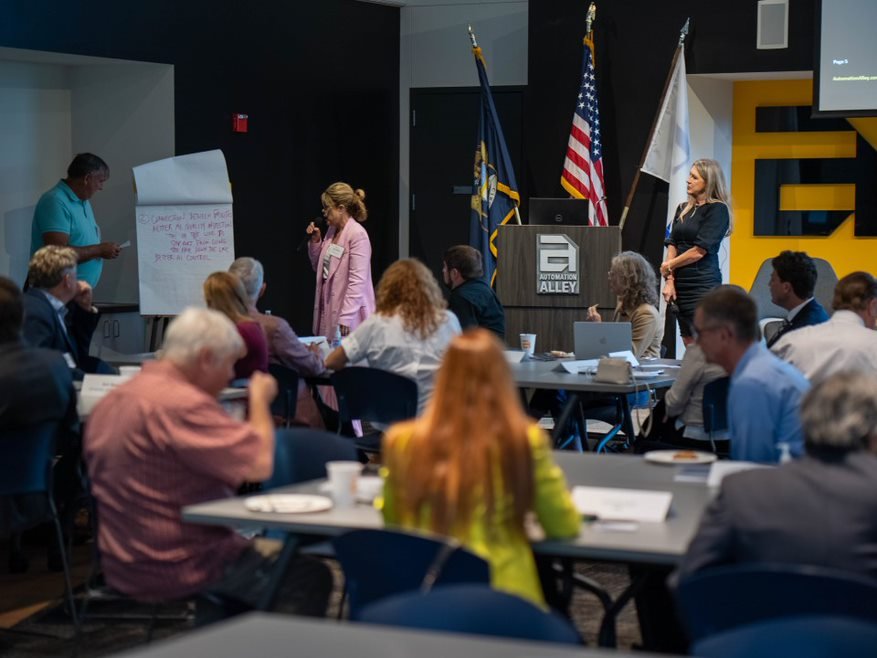Additive Manufacturing Insights from the Advanced Manufacturing Hub of Michigan
The US Center for Advanced Manufacturing, in partnership with The World Economic Forum, hosted a timely roundtable on Additive Manufacturing at Automation Alley’s Troy, Michigan headquarters on August 25 as part of its 2022 Industry 4.0 AMHUB roundtable series, which is centered around the most relevant and pressing issues facing advanced manufacturing today.
Article by: Nicole Kampe, Digital Editor
3D printing adoption is accelerating, and companies are recognizing the value that additive manufacturing can bring to their businesses. According to a 2022 report from the World Economic Forum, although not all additive manufacturing predictions and forecasts have become reality, it still manages an average yearly growth rate of 20%.
The AMHUB Roundtables bring together leaders from industry, academia, and government to promote connections and collaborations, share best practices, and spark industry conversations around solutions as the global manufacturing ecosystem is impacted by technological, economic, environmental, and societal disruptions.
In this roundtable session, participants shared insights on additive manufacturing, including current challenges, opportunities and key considerations businesses should take as they adopt 3D printing into their manufacturing process. By convening industry experts, our ecosystem can better work together to accelerate Industry 4.0 and stay globally competitive.
Below are the key takeaways from the roundtable discussion.
Industrializing additive manufacturing will involve innovation, sustainability, and inclusion
Scaling additive manufacturing and overcoming key challenges will hinge on industry’s ability to unlock and deploy innovative products, technologies, and solutions to increase value for manufacturers; drive sustainable and profitable growth; and empower every manufacturing worker with new opportunities through partnerships with industry, government, and academia. Here, we will dive deeper into these three main considerations.
Innovation – To unlock the full potential of additive manufacturing, it’s important for companies to understand 3D printing hardware, software, and material innovations. Having knowledge of the technology and what is truly capable today with 3D printing will help manufacturers make better business decisions and can help promote resiliency and flexibility.
Companies must prioritize bandwidth to explore R&D and identify designs for additive manufacturing that create differential value. Currently, additive manufacturing is not a replacement for subtractive manufacturing methods, but another toolset that can be leveraged. It’s about finding the applications that make sense for your business.
Sustainability – The software-first nature of 3D printing allows for rapid and adaptive responses to change that enable flexible and sustainable production systems and can unlock new business models. Because of this, companies should focus on enforcing circularity and sustainability goals.
The future of additive manufacturing will also require an agreement to a set of standards and policies to guide collaborations and protect businesses and their networks against cybersecurity risks. The industry must work through digital rights ownership issues and standardize quality and certification to ensure and verify that components produced across multiple locations are safe and functionally equivalent.
Inclusion – Change acceptance is difficult and developing products using additive manufacturing is a completely new way to do business that will require a culture shift within organizations. Companies must prioritize education and knowledge sharing for employees. Manufacturers must work to dismantle aging hierarchal structures to empower innovation from anywhere within the organization.
Designing for additive manufacturing means businesses must rethink the production of parts, recognizing the value of the whole. New, sophisticated, and intuitive relationships will develop between computer and engineer, with artificial intelligence creating generative designs and machine learning spotting anomalies and defects during printing.
In order for this to become a reality, government must continue to invest in additive manufacturing and provide incentives, businesses must prioritize training for employees, and academia must work with industry to develop additive manufacturing curriculum for the next generation of manufacturing workers.
A special thank you to the participating companies:
ABB
AON3D
APiS North America
ARM Institute
City of Troy
Dow
Eaton
General Motors
The Office of US Congresswoman Haley Stevens
HP
Ignite InfoSec
Infintrix Global
ISAIC
MacLean-Fogg Company
Macomb Community College
Newlab
Novastar Solutions
Oakland Community College
Oakland County
Phoenix Contact
Raytheon
Siemens Digital Industries
United Technical Solutions, LLC
University of Michigan - Flint

